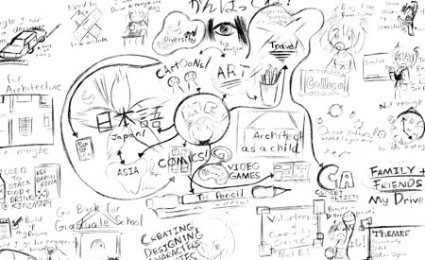Media Advisory: Visual maps provide career direction
While career plans may be crystal clear for some graduating seniors, others can benefit from a new approach Wake Forest is using to help students visualize their post-graduation path.
Katharine Brooks, Wake Forest University’s executive director of personal and career development, helps people navigate their career paths with wandering maps — or vision boards — that creatively capture the patterns and themes in one’s life including significant moments, activities, interests and feelings.
“As far as we know, we are the first university to set up a designated area in a career center with the tools and support to use visual thinking techniques to create a personal map,” says Brooks, the author of “You Majored in What? Mapping Your Path from Chaos to Career” and the Career Transitions blog on Psychology Today.
The map can be a simple pencil sketch or a colorful creation with magazine clippings and bright drawings. At Wake Forest, students make these in their college-to-career classes or in Studio 230 — the dedicated space in the career center filled with glossy periodicals and art supplies.
To begin a wandering map, put yourself in the center of the page. Then, working quickly, add short phrases, pictures and/or drawings of the things that have been most important in your life. Next, make connections that when you first look, seem to be dissimilar but are, in fact, linked in surprising ways.
Mapping a career
“One student of mine drew a line connecting her favorite TV show, ‘Law & Order: SVU’ to her love of playing poker, to having a sister with cerebral palsy,” says Brooks. “When I asked her what the connection was, she said all of those things honed her ability to problem solve and strategize. She liked to guess who the villain was in ‘SVU.’ She used strategic thinking in her tournament-winning poker playing. And because her sister had physical and learning challenges, she was always trying to come up with strategies for helping her gain access to inaccessible places and do better in school by finding other ways to help her learn.”
When designing a career path, Brooks says look at your whole life. What do you love? What were your struggles, and what were the turning points?
“Visual mapping moves the focus away from asking, ‘How am I going to make money?’ It’s a wide-angle view on choosing ways to make a living that fit within your life passions rather than just intersecting them in a small way,” Brooks says.
Applying the lessons
For senior Toia Gathings, creating a wandering map in her college-to-career class this semester helped her think differently about her post-graduation options.
“The map highlighted three key qualities about myself that I had never noticed before: self-determination, a joy in helping others and being results-oriented. The discovery swayed my career decisions a bit. Before the class, I was set on law school. After, I realized my personality may also be valuable in areas such as marketing and public relations. Inspired by the map, I applied to three marketing companies and have received a job offer,” Gathings says.
“Creating a wandering map isn’t just a feel-good exercise,” says Brooks. “We explore the difficult challenges that have tested our mettle. By identifying the skills in which we are particularly strong, we can think about how we would apply them in the workplace.”
Katharine Brooks has been providing career services for more than 25 years, specializing in the career needs of college students and adults in career transition. She has also worked with college students with attention deficit disorder and learning disabilities. Her expertise in career issues has been recognized nationally in The Wall Street Journal, The New York Times, US News & World Report, The Chicago Tribune, The Philadelphia Inquirer, Cosmopolitan, the Associated Press, and CNN/Fortune.
Brooks and students are available for interviews until April 30.




